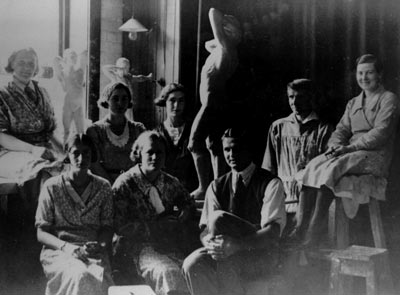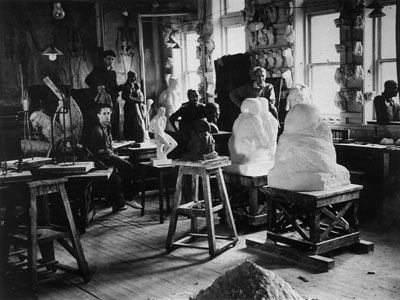| |
| Students of 1920–1930 |
| Rata Lovell-Smith |
1918–26 |
| Russell Clark |
1918–27 |
| John Weeks |
1920–22 |
| Chrystabel Aitken |
1921–30 |
| James Cook |
1922–25 |
| Olivia Spencer Bower |
1922–30 |
| Ivy Fife |
1926 |
|
| 1920 |
A former student, Archibald F. Nicoll O.B.E., is appointed Director (1920–1928). John Weeks is appointed to a part-time position. Instruction in the crafts and architecture is gradually phased out between 1920–1930, due in part to the establishment of rival institutions. An increasing emphasis is given to drawing and painting. During the 1920s and 1930s the art school develops the reputation as being the foremost and most progressive in the country producing some of New Zealand's most promising artists of the period.
James Shelley (1884–1961) is appointed as the new Professor of Education at Canterbury College. Shelley had lectured in art history at University of Manchester before coming to New Zealand and had a considerable knowledge of the philosophy of art. Professor Shelley gave the first of his series of lectures on the history of art in 1921. 'As early as 1921, in his Lyttelton Times reviews, James Shelley was calling for artists to break away from the mother culture of England and develop a distinctively New Zealand art. It was not until 1929 that he felt this had begun to happen, and that painting truly reflected what was real about our country.' (Terri Elder, Southern Exposure)
Dressmaking and millinery classes are held in the needlework room. |
| 1921 |
Special classes this year include millinery and dressmaking (art), illustrating (commercial, fashion, book and newspaper). |
| 1924 |
Rata Lovell-Smith is appointed to staff (1924–45). Francis A. Shurrock (RCA graduate 1909–13) starts at the School as Modelling Master (1924–48) Over the next 24 years Shurrock, as a sculptor and inspired teacher, exerts a considerable influence on a whole generation of Canterbury students. |
| 1925 |
The Royal Commission on University Education examines the question of establishing a degree or diploma course in Fine Arts, recommending that 'a course of training for art teachers and especially art teachers for technical schools should be developed.'
Hilda McIntyre (sister of the painter Raymond McIntyre) is employed (1925–38) as a part-time teacher of design and embroidery. |
| 1926 |
Louise Henderson (née Sauze, of Paris) is employed as an instructor of design and embroidery (1926–33). James A. (Johnny) Johnstone is appointed to staff as Crafts and Design Master (1926-, Senior Lecturer 1949–58). Trained at Edinburgh College of Art, Johnstone was instrumental in the development of art metalwork at the school.
From 1926, senior student Chrystabel Aitken assisted Francis Shurrock with junior modelling classes (1926–30). |
| 1927 |
The School of Art becomes a special school of Canterbury University College, and the Diploma of Fine Arts is approved by the University of New Zealand.
Colin Lovell-Smith is appointed to staff (Careers Advisor 1927–38, Acting Head 1945–46, Director 1947–60). Senior student Florence Akins appointed to part-time staff (with Gladys Anderson and Ivy Fife) teaching drawing and plant-form design and later design. She taught full time 1936 to 1966, and retired in 1969. Archibald Nicoll resigns as Director to become a full-time painter.
'The most popular art school in New Zealand, primarily for its emphasis on painting, the CCSA also had particular strengths in its teaching of design and artcrafts, and these were seen as equally necessary for its proper purpose. Archibald Nicoll, head of the school from 1920 to 1928, urged the school board to appoint "artists and craftsmen of recognised ability". Otherwise, he said, when the diploma was introduced in 1929, students would aim at that only. Quoting from the constitution "of one of the most successful Colleges of Art in Britain [the Royal College of Art]," Nicoll said: "The members of the staff actually practise what they teach, and are men and women whose repute as Artists enforces their influence as teachers."' (CCSA Annual Report for 1927/1928, p.32, quoted in Ann Calhoun, Simplicity and Splendour, p.41)
Formation of The Group, an artists' collective formed as an alternative to the Canterbury Society of Arts, is also a means of rekindling the sense of association enjoyed as art students. 'The Group has been described as an attempt to break with the CSA and its conservative tradition, but Evelyn Page remembers it more as a social club for young painters who wanted to find somewhere to meet away from their Victorian parents. She and her friends from the School of Art were its foundation members. (Janet Paul, Evelyn Page: Seven Decades, pp.22–23) |
| 1928 |
Richard Wallwork, A.R.C.A. becomes Director (1928–45). Other staff appointments made in 1928 include Leonard Booth (1928, 1933- ); Florence E. Akins appointed initially part-time (staff 1929–31, 1936–66, Lecturer 1936); Rata Lovell-Smith (equivalent full-time Lecturer, 1928–45), and A. Elizabeth Kelly (equivalent full-time Lecturer 1928). |
| 1929 |
The School is approved by the University of New Zealand for the award of the Diploma in Fine Arts.
A site for a new School of Art at the corner of Montreal and Gloucester Streets (on Ross House site) is purchased, but this plan is thwarted by the Depression. The Christchurch Art Gallery opens on the site on 10 May 2003. |
|

| Francis Shurrock's Sculpture Class, c. late 1920s |
Elizabeth Shurrock and Francis Shurrock are present in the group photograph. Francis Shurrock was a popular teacher, of whom his student Bill Sutton later commented that Shurrock 'taught them how to think.' (Mark Stocker. Francis Shurrock: Shaping New Zealand Sculpture,.Dunedin: University of Otago Press, 2000, p.44.) |

| Sculpture Class, Canterbury College School of Art, c. late 1920s |
Lecturer Francis Shurrock and his class are working in the school's sculpture studio, known today as 'Annie's Wine Bar'.
Shurrock came to New Zealand under the La Trobe Scheme in 1924, and was influential on a generation of artists including Molly Macalister, Alison Duff, Rita Angus, Toss Woollaston, and Jim Allen. Chrystabel Aitken, who both studied and taught with Shurrock, recalled him saying: 'You need roots, good basic principles, that don't change with fashion. It's what you build on. You either throw them out or use them.' (Mark Stocker, Francis Shurrock, p.48.) |
|


